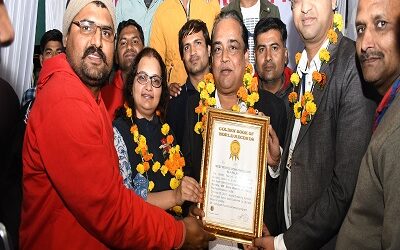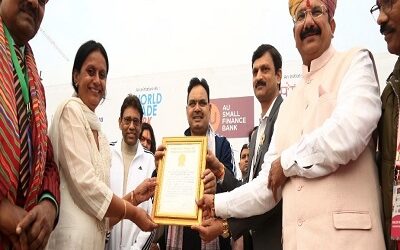This year, after the last two unpleasant years, the residents of Purvanchal, living in Indore, will perform the ritual of worship in the water tanks with unprecedented enthusiasm. According to the information given by the Northeast Cultural Institute, Madhya Pradesh, Indore, the four-day Chhath festival of sun worship will begin on October 28, 2022 (Friday) with Nahai Khay. On this day the house will be cleaned and purified by Chhath fasting people and their relatives. After that Chhathvrati will start the fast after taking a bath and taking pure Satvik food. After taking the food of Vrati, the rest of the family members will take food. On the second day of the festival, Kharna will be organized on October 29 (Saturday), under which fasting in the morning, bathing, and meditating, will fast for the whole day. On the same day in the evening, a new earthen stove made of mango wood will be used for worship, and offerings of kheer made of jaggery and wheat bread will be offered. After taking this Prasad, the 36 hours waterless fast of Chhath Vrati will start. On the next day of Kharna, Prasad will also be made in the houses of Chhath Vrati to offer Arghya to Lord Surya.
The unique context of Sun worship:
Shashthi Puja is a symbol of world culture-In the folk life of Bihar, the Shashti festival is celebrated on the Chhath Tithi which comes after Diwali in the month of Kartik. Sun is worshiped twice in the Chhath festival. One of the setting sun and then of the rising sun. This festival also belies the saying that everyone worships the rising sun and no one worships the setting sun. That means, even in human beings, everyone respects the one whose fortune is high, but no one looks at the one whose fortune is in the dark.
This regional festival is not bound by the boundaries of the country and the state. The people of Bihar and Uttar Pradesh took this festival of folk tradition with them wherever they went. About 25 lakh people gather on the beach of Mumbai on the day of Chhath. So the descendants of Biharis who went abroad as indentured laborers have not forgotten this festival in Mauritius, Fiji, South Africa, and America’s Caribbean countries Trinidad, Tobago, and Suriname.
In the public life of Bihar, the preparation of the fast which is started months in advance with a lot of purity and purity and which is performed with reverence for four days of penance is Chhath Vrat. This festival is known as a folk festival within the limits of regionalism. In this, worship and worship are done to Lord Diwakar, the creator of the universe. Apart from Bihar, it is celebrated with great pomp and devotion in Uttar Pradesh, Bengal, and other states as well as Madhya Pradesh.
Chhath festival defines life:
Chhath Puja renders the importance of sun and water between nature and human life. This worship teaches us how close the sun and life are. In Chhath Puja, offering Arghya to the sun with water means we offer Arghya to the rays present inside us. Water teaches us that the way it removes the obstacles coming in its path by changing its path, in the same way, we should also make our path in life i.e. how to avoid obstacles in life. Because in this world, the more soft and humble we are like water, the more successful and meaningful our life will be. Sun and water help make our surroundings and environment friendly to our lives while nurturing nature. The importance of sun and water in Chhath Puja is a sign of influencing human life. When we offer Arghya to the Sun, at that time we are offering Arghya to the Sun as well as to the light i.e. the rays present inside us. The worship of the rising and setting sun in Chhath Puja gives us the message of treating one’s fortunes equally in life, rising and setting.
Chhath festival is celebrated twice a year:
This fast is observed twice a year in Bihar. Bihar residents settled in different parts of the country try to return to their native land. This fast is observed once a year on the Shukla Paksha Chhath of Chaitra month, which is called Chaiti Chhath. The second time it is done on Chhath of Shukla Paksha of Kartik month. This is called Katki Chhath. Katki Chhath is given more importance in public life. This is because the month of Kartik is considered a month of virtue. The second argument is that since autumn starts from the month of Kartik, there is less pain in fasting in this month. That’s why the number of people who perform Katki Chhath is more. Along with Chhath Vrat, Surya Shashthi is also celebrated in the name of Dala Chhath in some places. Chhath, a cultural fast of Hindu society, is mainly performed by women but some men also do it.
Main places of worship in Bihar:
This festival is also celebrated near the sun temples or in the sun pools. Every year lakhs of devotees gather near the ancient Sun Temple of a place called Dev in the Aurangabad district of Bihar and offer prayers to the Sun by taking a dip in the Surya Kund. Fasts also gather near the Sun Temple in Bargain near Rajgir. The Sun Temple at Ular and Pandarak in Patna district, and the Sun Temple at Madhusrava near Arwal in Jehanabad district are particularly famous where devotees worship.
Four days of worship:
Chhath is the only fast in which the setting sun is worshiped first and then the rising sun. From the beginning of the fast till the end of the rituals, there are songs related to Chhath Vrat day and night. On Chaturthi fasting is done by bathing and worshiping and then after preparing pure food with strict rules and eating only during the day. It is also called “Naha Khay” or “Nahay Khay” in Bihar region. After this method i.e. from the day of taking a bath, the fast is considered to start. On that day, only Arva rice or rice, gram dal, and plain chopped vegetables of pumpkin are taken in the food. On Panchami, fasting for the whole day, bathing in the evening and worship, and then eating kheer and roti. This is called Kharna. This is done only after seeing the moon. Fasting on Shashthi in the evening on the banks of a river, pond, or pond, offering various dishes, fruits, flowers, betel nut, roli, Akshat, milk, etc. at sunset. After decorating the worship material in new soups made of raw bamboo, they offer Arghya facing the setting sun and return home. At the time of offering Arghya, the fasting person prays to Lord Surya for the well-being of his family. On the morning of Saptami, as in the evening of Shashthi, the ritual of fasting ends by offering Arghya to the rising sun by standing on the banks of the water at the same fixed places as before.
The local but distinctive culture of Bihar can be seen and experienced the way by observing Chhath Vrat. There is a wonderful harmony of folk songs, personal beliefs, fruits, flowers, costumes, and food habits of the culture there. Dressed in traditional costumes, every section of the society gathers together at the Ghat i.e. the place of worship without any discrimination. On the day of Chhath, in the evening, women prepare fruits, flowers, dishes, and light lamps. The male member of the house lifts the dala on his head and walks towards the ghat. Dala i.e. Daura (Udara) seems like a race to carry it on the head. Women sing folk songs behind it.
कांच ही बांस के बहन्गिया,
बहन्गी लचकत जाय।
बाट में पूछेला बटोहिया,
बहन्गीब केकर जाय।
तू आन्हर हवे रे बटोहिया,
बहन्गी सूरज के जाय।
Folk songs adorn Chhath Puja:
It is believed that folk songs have their importance during the festival of folk tradition. Unless they are included, there is no joy in that festival. Chhath festival has also been a rich tradition of folk songs. Without them, the enthusiasm and gaiety of the Chhath festival seems incomplete. The folk songs that are sung at this festival on traditional folk tunes are as follows-“सोना सटकोनिया हो दीनानाथ,,
डोमिन बेटी सूप लेले खाड़ छैई, उग हो सुरूज देव भईल अरग के बेर,,
केरवा जे फरेला घवद से, ओह पर सुगा मेड़राय,,
There are many songs that women patrol in groups at home and on the ghats. Not at first, but gradually famous singers also gave their voice to the importance of these folk songs. Now cassettes and CDs of these songs are also available. Among them Anuradha Podwal, Chandan Tiwari, Kalpana Patwari etc. are prominent.
This is also tradition:
A tradition is also associated with this festival that if a wish has been given to someone, then that man or woman goes from their house to the Ghat while paying the penalty. After returning from the evening Arghya, the Kalsupas are expelled from the Dwara. Dishes are changed and new dishes are kept. Somewhere the fruits of the soup are also changed along with the dish. The cell is filled at night. Filling the Koshi means filling the lap of the sixth mother. Being Chhath Tithi, it is considered Chhathi Maiya. After filling the Koshi, the burning lamps are thrown into the river or pond. It is very beautiful to see the floating of lit lamps on the banks of the river in the darkness of the night before dawn. The rituals of Chhath are not completed after the worship of the setting sun, but there is a vigil on the Ghat that night. On the second day in the morning, fasting women stand in the water for hours and wait for the sunrise to offer morning, Arghya. There is a belief among those who observe Chhath fast that by doing it regularly, all the troubles go away and there is an increase in wealth and grains in the house.
Legends are also prevalent:
It cannot be said with certainty when and how the fast of Chhath started, but legend has it that it started during the Mahabharata period. This is the popular story that when the Pandavas lost their kingdom in Jai and were in great trouble, then Draupadi’s wishes were fulfilled by this fast and the Pandavas got back the kingdom. On the other hand, it is also said that the beginning of this fast was Danveer Karna.
Thakur Jagdish Singh, President of Northeast Cultural Institute, Madhya Pradesh, and General Secretary KK Jha said. According to the latest data received by the institute, this year Chhath Puja is being organized at more than 110 Chhath Ghats in Indore by various Chhath Puja organizing committees of the city.




